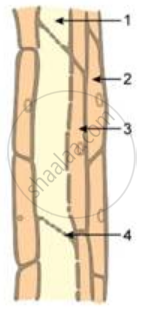Advertisements
Advertisements
प्रश्न
Explain different types of elements present in phloem.
उत्तर
Phloem consists of following four elements:
(i) Sieve tubes: These are slender, tube-like structures composed of elongated thin walls placed end to end. Their end walls, sieve plate, are perforated by large number of pores. Sieve tube elements lack nuclei, but they remain alive via adjacent companion cells.
(ii) Companion cells: They are connected with the sieve tubes via plasmodesmata. They are thin-walled cells consisting of dense and active cytoplasm and large, elongated nucleus.
(iii) Phloem parenchyma: As the name suggest, they consist of living parenchyma cells. They are involved in storage and lateral conduction of food.
(iv) Phloem fibres or bast fibres: These are dead cells of phloem possessing a narrow lumen. They are meant for providing mechanical support to the phloem.
APPEARS IN
संबंधित प्रश्न
What are the functions of the stomata?
Why are xylem and phloem called complex tissues?
Draw a well labelled diagram of phloem.
What do you know about complex tissue? Classify and explain its different types in plants with suitable diagrams.
Parenchyma containing chloroplasts is known as :
Study the diagram given below and then answer the question that follows:

Name the parts labelled 1, 2, 3 and 4.
Define the following:
Permanent tissue
Differentiate between:
Collenchyma and Sclerenchyma
Give the structure and function of the following:
Crystal
The question has four answers. Choose the correct answer:
Phloem parenchyma, sclerenchyma, sieve tubes, and companion cells are found in
